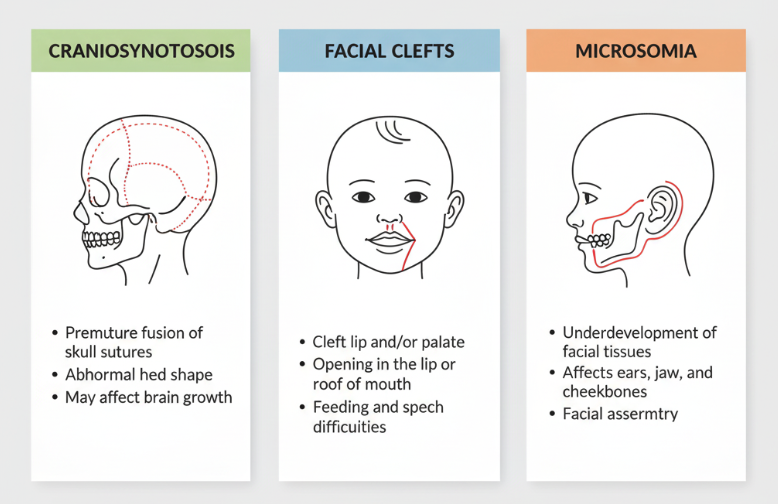Craniofacial disorders refer to a variety of congenital or acquired conditions that affect the skull and facial bones. These disorders can impact the appearance and function of a child’s face, skull, and brain. Common craniofacial disorders include craniosynostosis, cleft lip and palate, and craniofacial syndromes.
Types of Craniofacial Disorders
- Craniosynostosis: A condition where one or more of the sutures in a baby’s skull close too early, affecting normal skull and brain growth.
- Cleft lip and palate: A congenital condition where there is a split or opening in the upper lip and/or the roof of the mouth.
- Craniofacial syndromes: These include conditions like Crouzon syndrome, Apert syndrome, and Pfeiffer syndrome, where craniofacial abnormalities are associated with other health problems.

Symptoms in Children
Symptoms vary depending on the type and severity of the disorder:
- Abnormal head shape or facial features
- Difficulty with feeding (especially in cases of cleft lip and palate)
- Hearing problems
- Delayed development or cognitive delays (especially in syndromes involving brain malformations)
Teşhis ve Tedavi
The diagnosis is usually made at birth through clinical examination and imaging studies such as CT scans and MRIs. Treatment often involves surgery to correct the deformities and improve function. In some cases, orthodontic and speech therapy are also necessary.
Are craniofacial disorders preventable?
While many craniofacial disorders are congenital, early intervention can greatly improve outcomes. Genetic counseling may help determine the risks in families with a history of these conditions.
What are craniofacial disorders?
Craniofacial disorders are conditions that affect the bones and tissues of the head and face. These can include abnormalities in the skull (such as craniosynostosis), face, jaw, and teeth (such as cleft lip and palate).
What are the symptoms of craniofacial disorders in children?
Symptoms vary depending on the type of disorder. Common symptoms include unusual head shape, facial deformities, difficulty with feeding (especially in cleft lip/palate cases), hearing loss, and delayed development.
How are craniofacial disorders diagnosed?
Craniofacial disorders are diagnosed through physical exams and imaging studies like CT scans, MRIs, and X-rays. Genetic testing may also be performed if there’s a suspected genetic syndrome involved.
Can craniofacial disorders be treated?
Yes, many craniofacial disorders can be treated with surgery, especially craniosynostosis ve cleft lip/palate. Surgical interventions aim to improve the appearance and function of the face and skull. Other treatments, such as orthodontics and speech therapy, may also be needed.
Are craniofacial disorders genetic?
Are craniofacial disorders genetic?
Some craniofacial disorders, such as Crouzon syndrome veya Apert syndrome, are genetic. These disorders may run in families, while others occur sporadically without a known family history.

 İngilizce
İngilizce
 Türkçe
Türkçe
